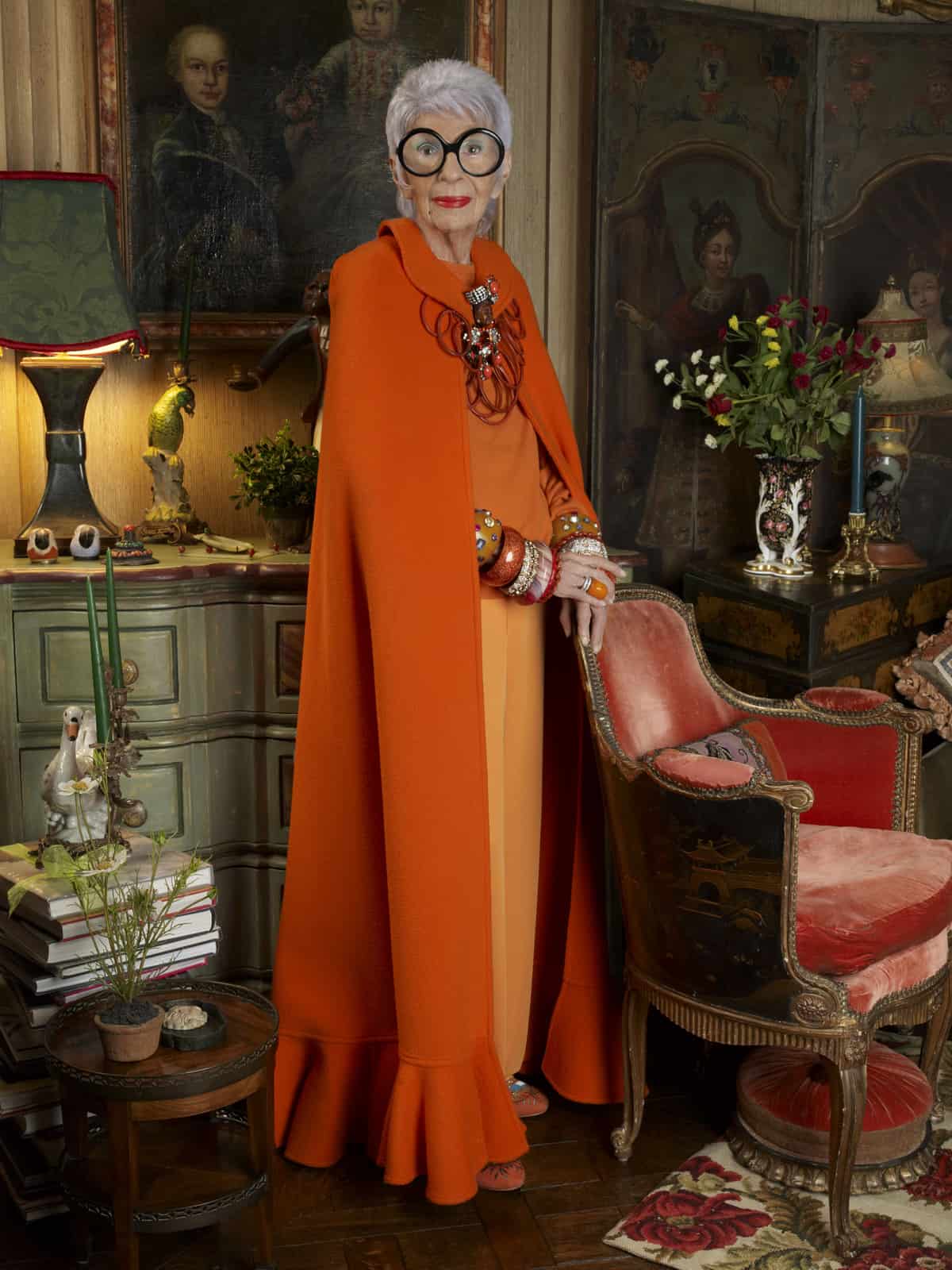“Oh my God,” Iris Apfel says, sighing, when asked about the projects on her plate. There’s the whimsical collection of memories and musings that make up the 96-year-old fashion star’s new book, Iris Apfel: Accidental Icon, which HarperCollins releases this month; the accompanying launch party, five-window display, and pop-up shop at Bergdorf Goodman; a roughly 50-piece collection of home furnishings in collaboration with Grandin Road; and, in the works, a line of porcelain jewelry with Bernardaud and a one-of-a-kind Barbie doll Mattel is making of her. This is all on top of designing her ongoing jewelry and clothing lines for HSN and mentoring young fashion students as a visiting professor at the University of Texas at Austin’s “UT in NYC” program.


“I’ve always worked very hard, but I lost my husband two and a half years ago, and we were together for 68 years,” Apfel says over the phone from her home in Palm Beach. “It was a very powerful loss, and I decided I wasn’t going to stay home and weep. I’m work-work-working, and I love it.”
The Queens-born Apfel had a successful first career in interior design, as the founder of Old World Weavers, the textile manufacturing company she started with her husband, Carl, in 1951. Although their work brought the couple to Europe, North Africa, the Middle East, and even the White House—they worked on decorative restoration projects for administrations from presidents Truman through Clinton—it wasn’t until age 84 that she became, as Apfel now calls herself, a “geriatric starlet.”
“‘Accidental icon’ is the absolute truth,” she says. “I never had a business plan; I never had a plan for anything. This is the last thing I thought I’d be doing in my dotage.”
Apfel’s second act really began in 2005, when she became the first living woman who was not a fashion designer to be the subject of a solo exhibition at the Metropolitan Museum’s Costume Institute. Rara Avis: Selections from the Iris Apfel Collection featured 40 different accessories spanning 40 years—from a Gripoix brooch to plastic cuffs—which Apfel styled on mannequins she dressed in clothes from her own wardrobe, like a 19th-century ecclesiastical vestment paired with Dolce & Gabbana lizard pants. The show introduced Apfel’s worldly, high-low, texture- and pattern-rich style to a wider public audience, and, through word of mouth, it became a must-see among the fashion elite, attracting A-listers like Karl Lagerfeld, Giorgio Armani, and Carla Fendi.

“Iris is such an extraordinary aesthetic project herself,” says Harold Koda, the Costume Institute’s former curator in charge, who oversaw the exhibition. “I said at the time, ‘Do not attempt this at home!’ What people don’t understand is that this kind of fashion collage can descend into risible chaos if the person composing it doesn’t have a highly sophisticated aesthetic background.”
People really have a yearning for glamour and fantasy and mystery. They like all this stuff they say they don’t.
Then, in 2014, documentarian Albert Maysles released Iris. The film follows Apfel as she haggles over bangles at a Harlem market, makes an appearance on HSN to sell her Rara Avis jewelry line, and celebrates her husband’s 100th birthday. It provided an intimate portrait of Apfel’s life as a 90-something celebrity and further boosted her profile outside of the fashion world.
“People really have a yearning for glamour and fantasy and mystery,” Apfel explains of her style’s appeal. “They like all this stuff they say they don’t; they [say they] want to be so casual.” (Her outfit today, ironically: “Flannel pajamas. It’s cold here.”) She cites the hours she spent playing with fabric swatches at her grandmother’s house in Brooklyn and her mother’s resourcefulness with accessories during the Depression as formative experiences, yet she contends that style is the type of innate personal quality that cannot be taught: “It’s part of your DNA.”

Apfel’s quick wit and knack for pithy observation have also made her a natural at handling the media onslaught that accompanies every project. (She has never employed a personal publicist.) With aphorisms like “If your hair is done properly and you’re wearing good shoes, you can get away with anything” and “When the fun goes out of dressing, you might as well be dead,” she’d be a natural on Twitter or Instagram—except for her conviction that social media is having a “disastrous effect” on young people. “They don’t know how to relate to one another; they don’t know how to do anything except press buttons. I’m very opposed to it,” she laments. “I have a huge following on Instagram, but I don’t understand it.” (Her fan-run Facebook and Instagram accounts have more than 880,000 followers combined.)
As she enters her late 90s, Apfel maintains the wonder, curiosity, and drive that have guided her colorful life. “I’m always sitting on the edge of a volcano,” she says. “If I have a nice, quiet day, I get nervous.” She still seems tickled by her fame, noting that she was “thrilled” that acclaimed interior designer Carleton Varney told her he was gifting a piece from her jewelry line to Gloria Vanderbilt and “so excited” to discover that she has a “contingent of drag queens” who buy her HSN products.
“I think it’s all about the way you look at things,” she says. “It’s like with age. You know, to me, everybody’s young. Like, if you’re 90 years old and you ask me out on a date, I feel like a cougar.”





